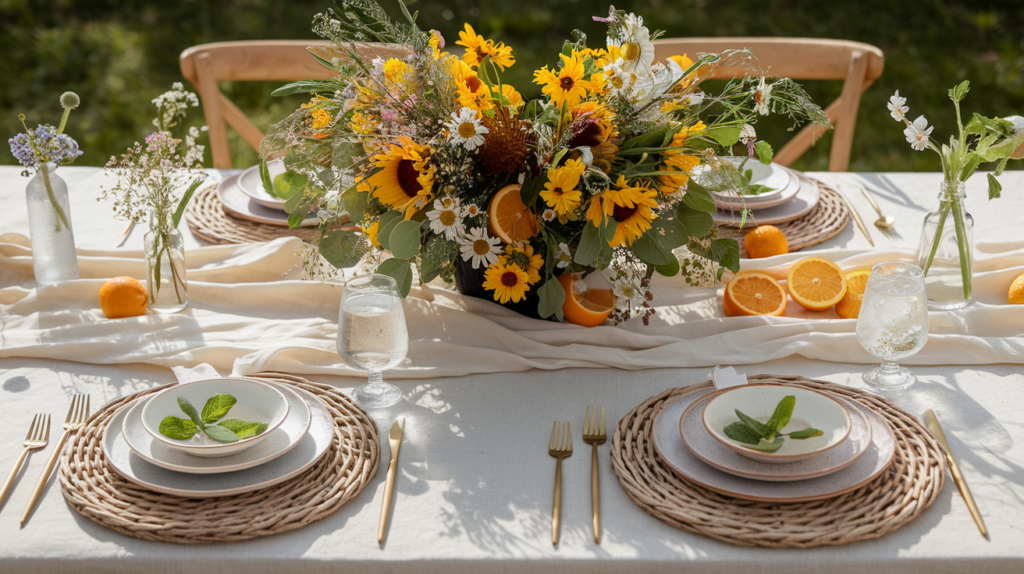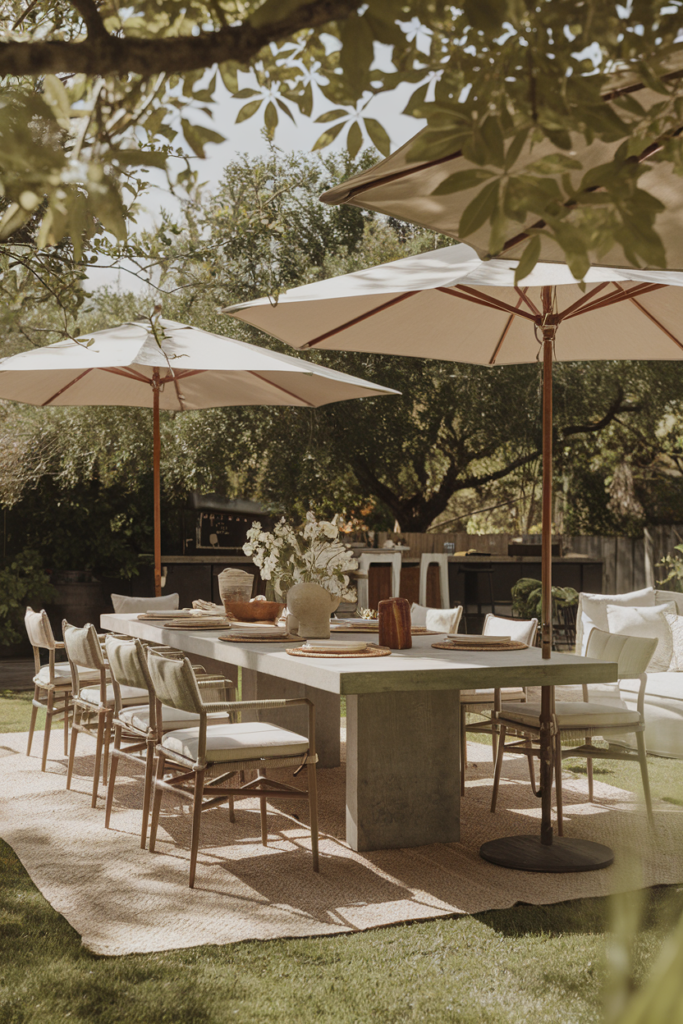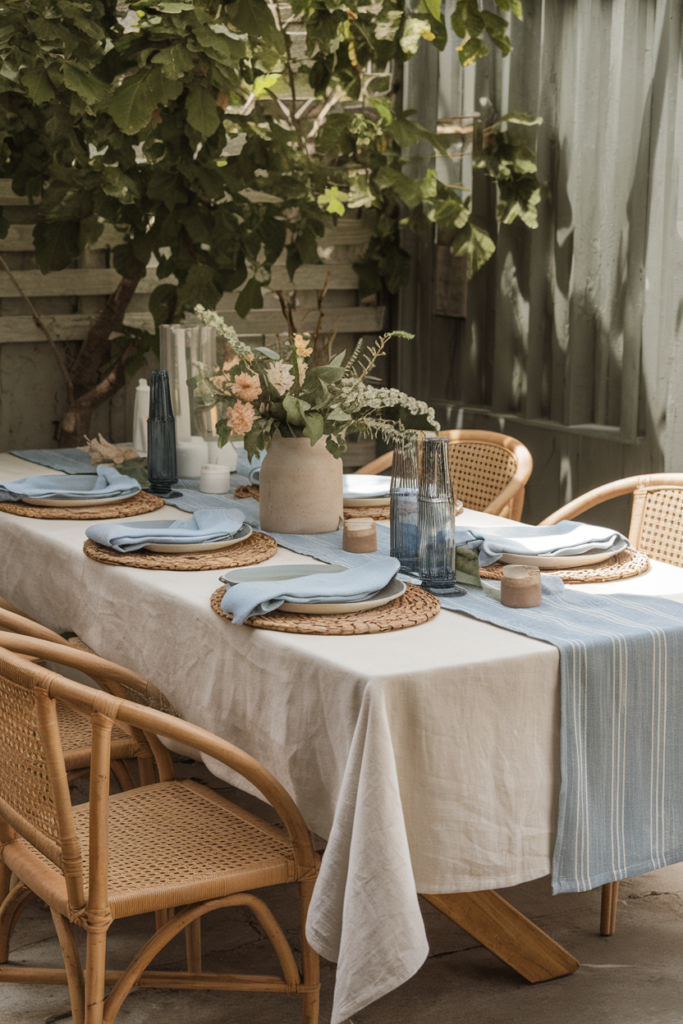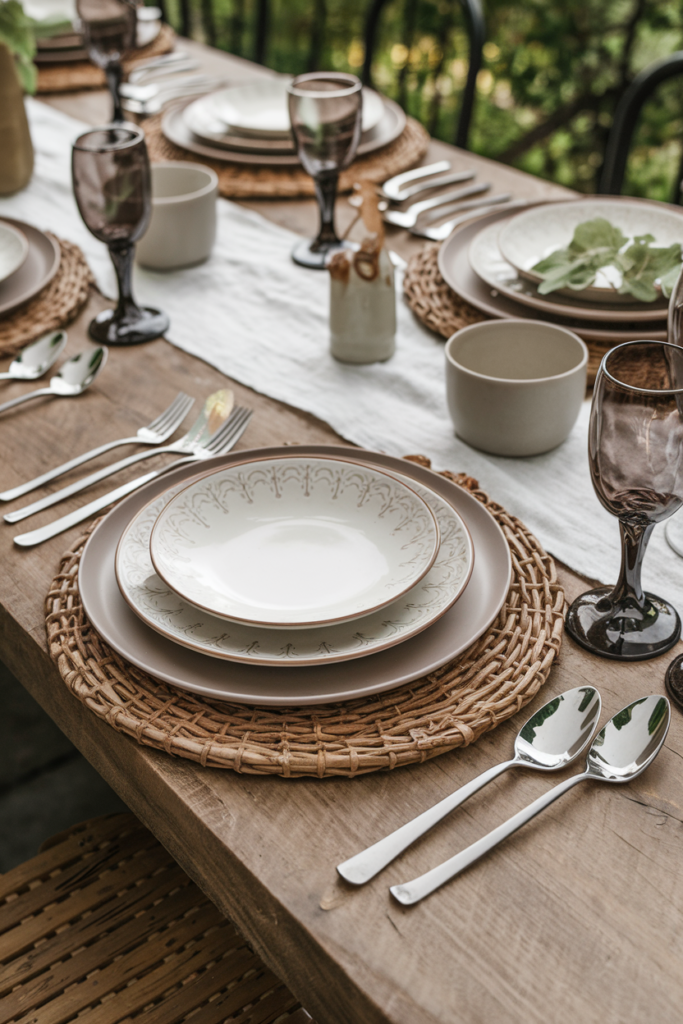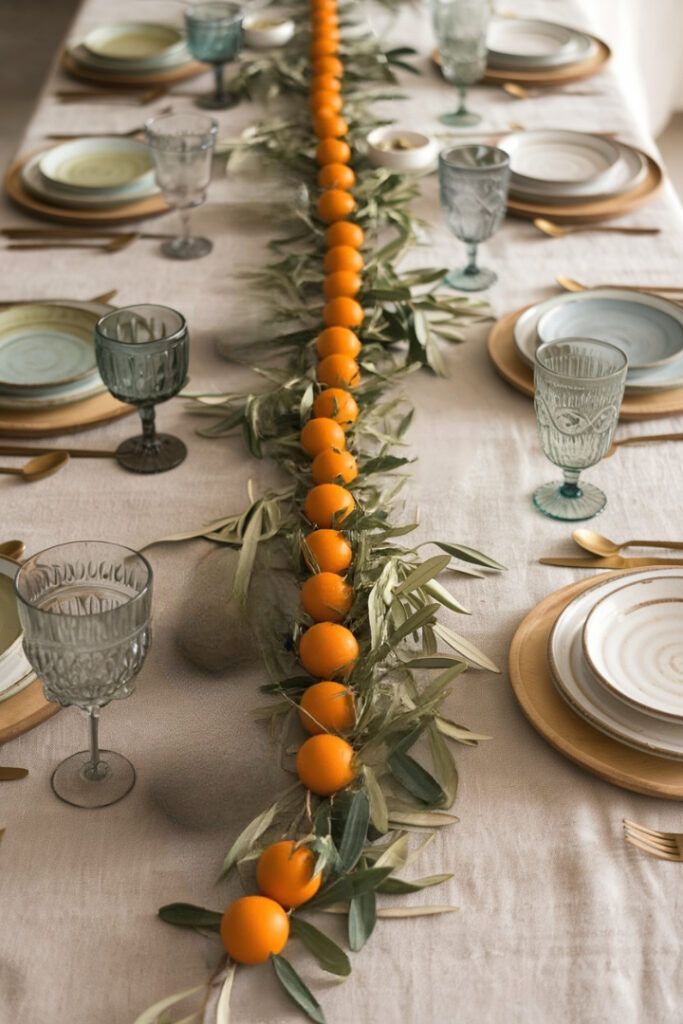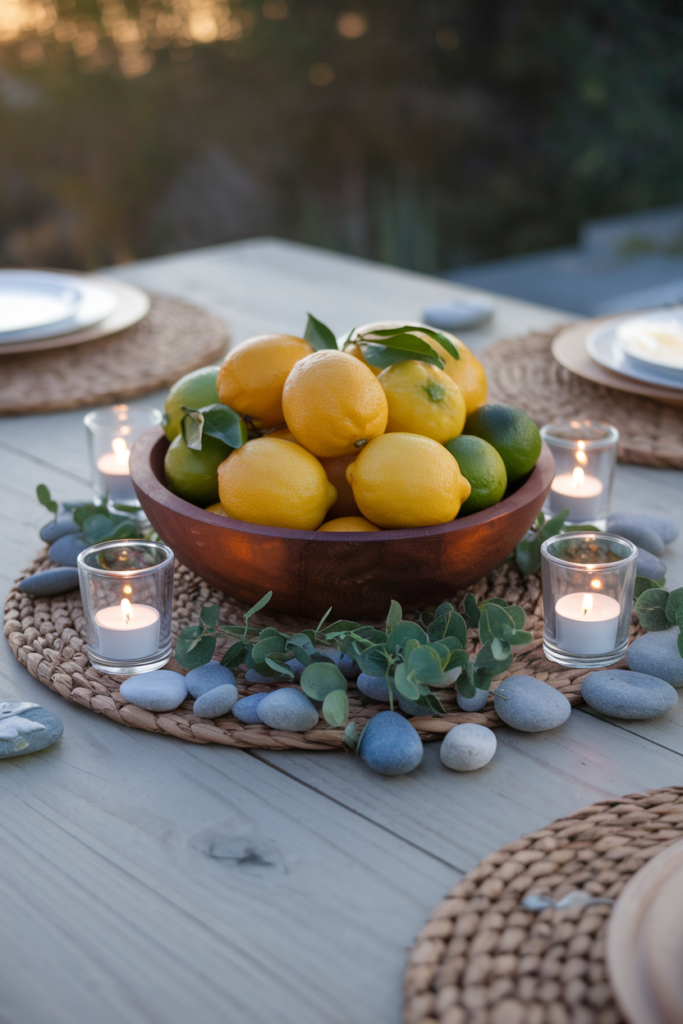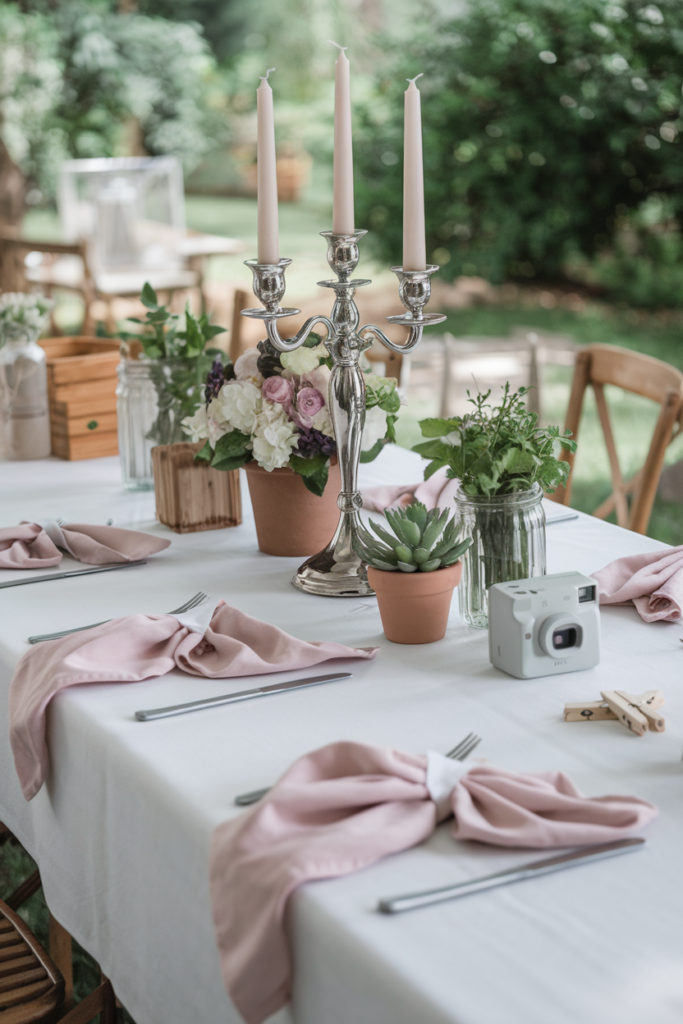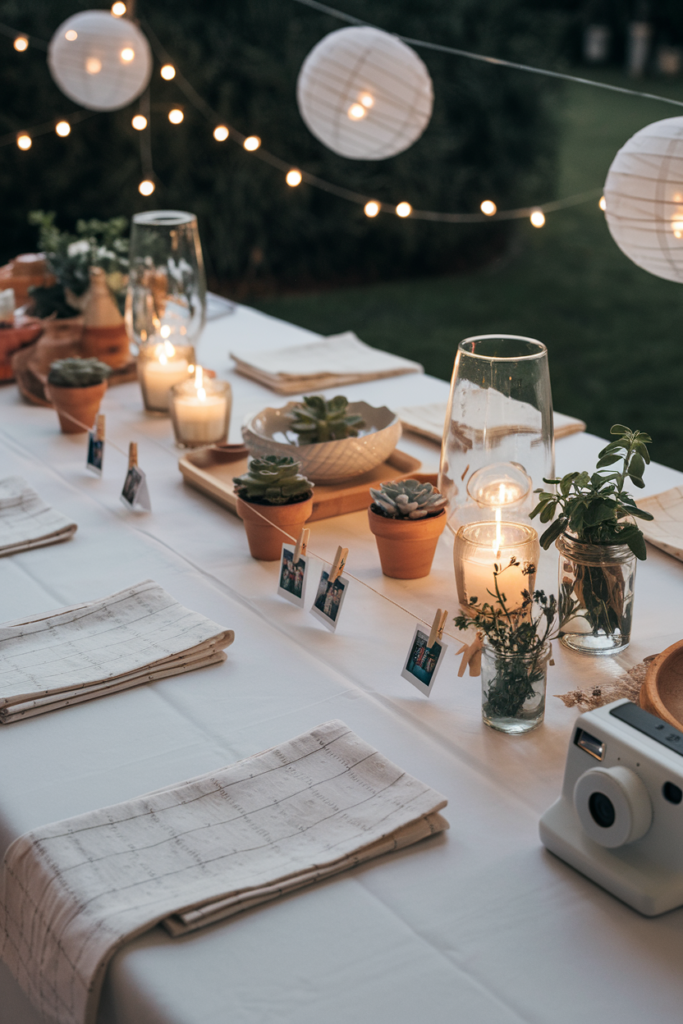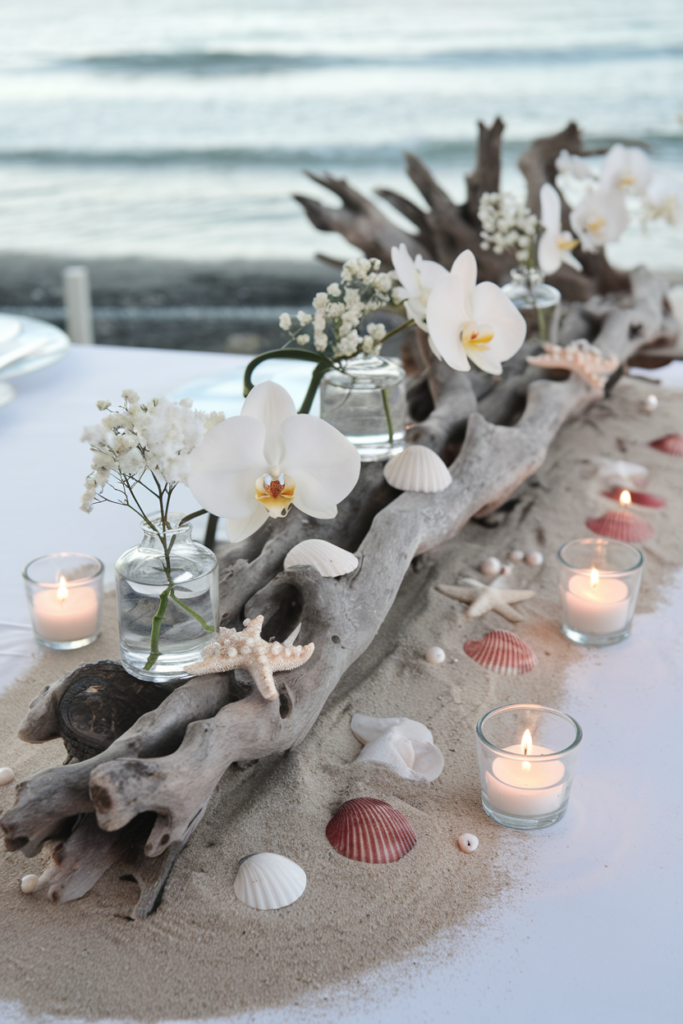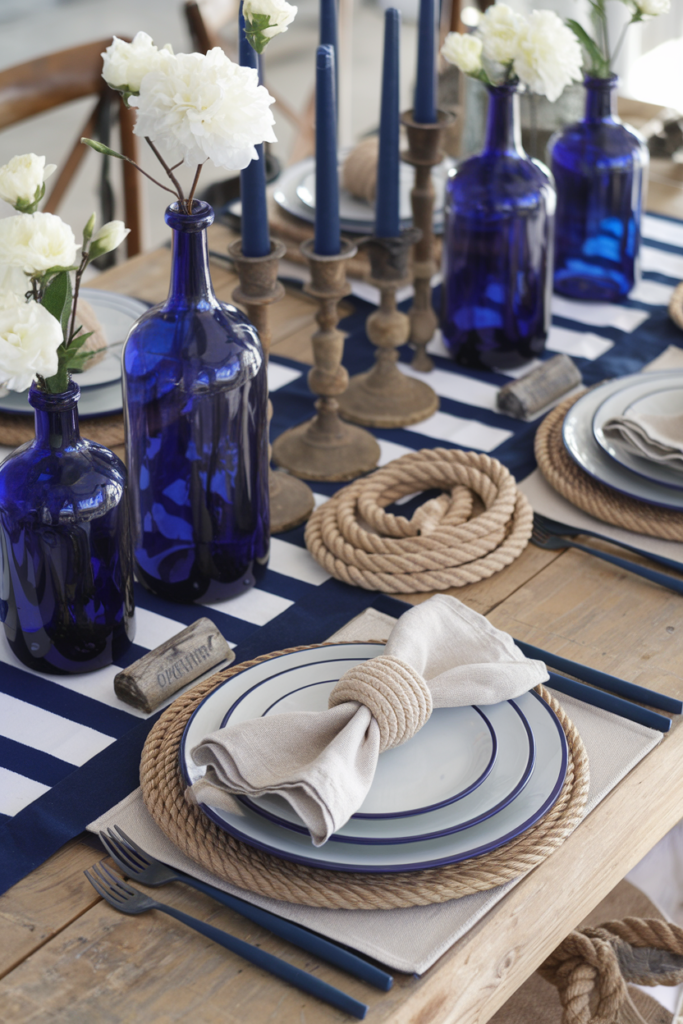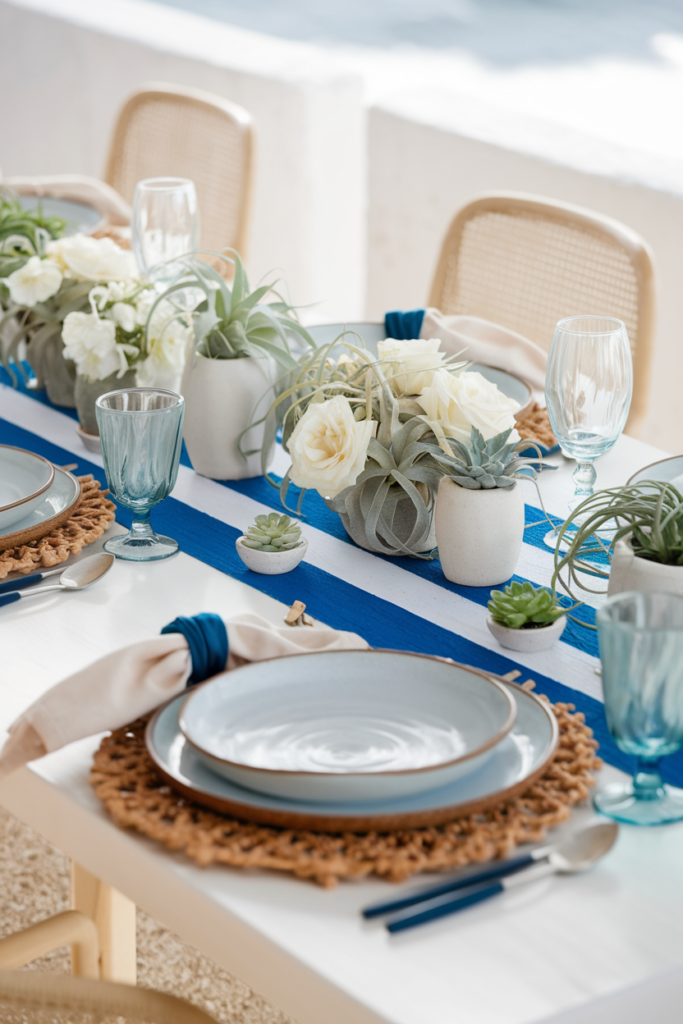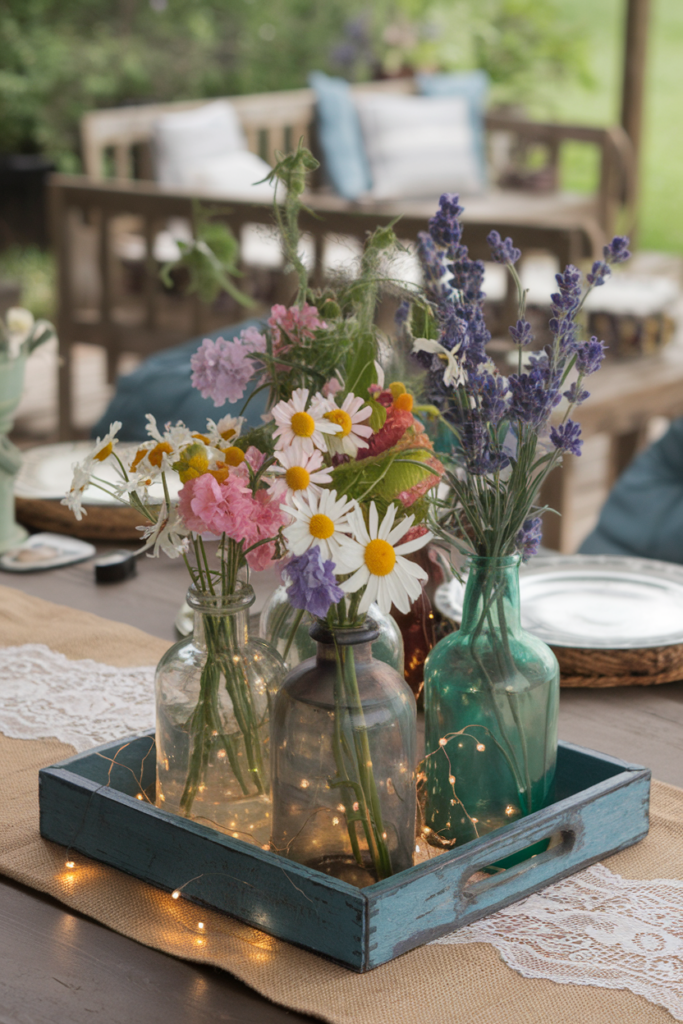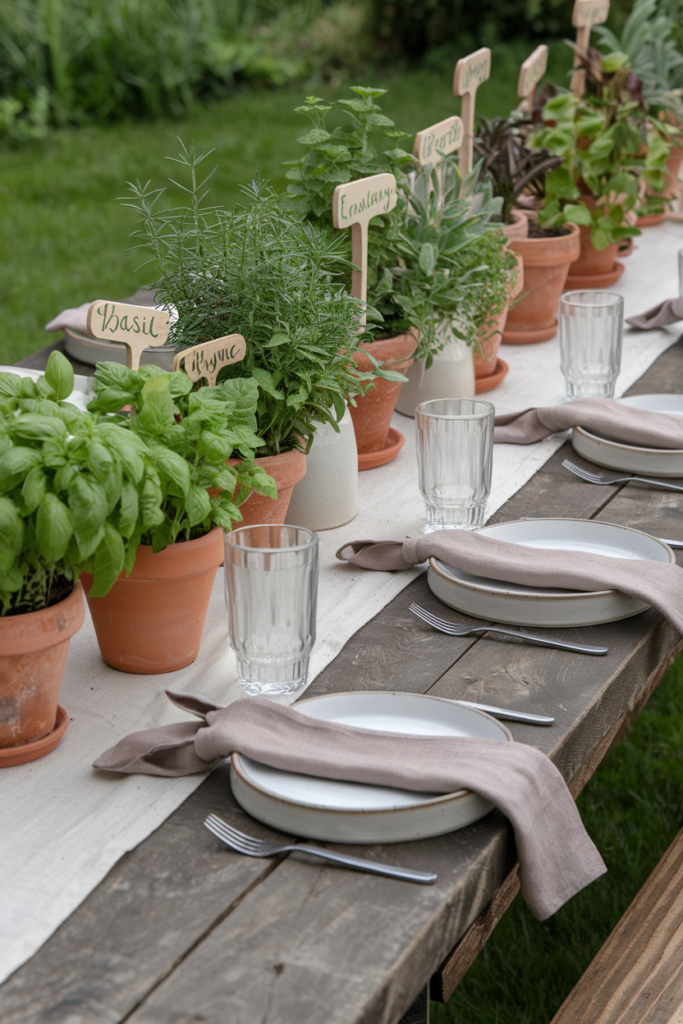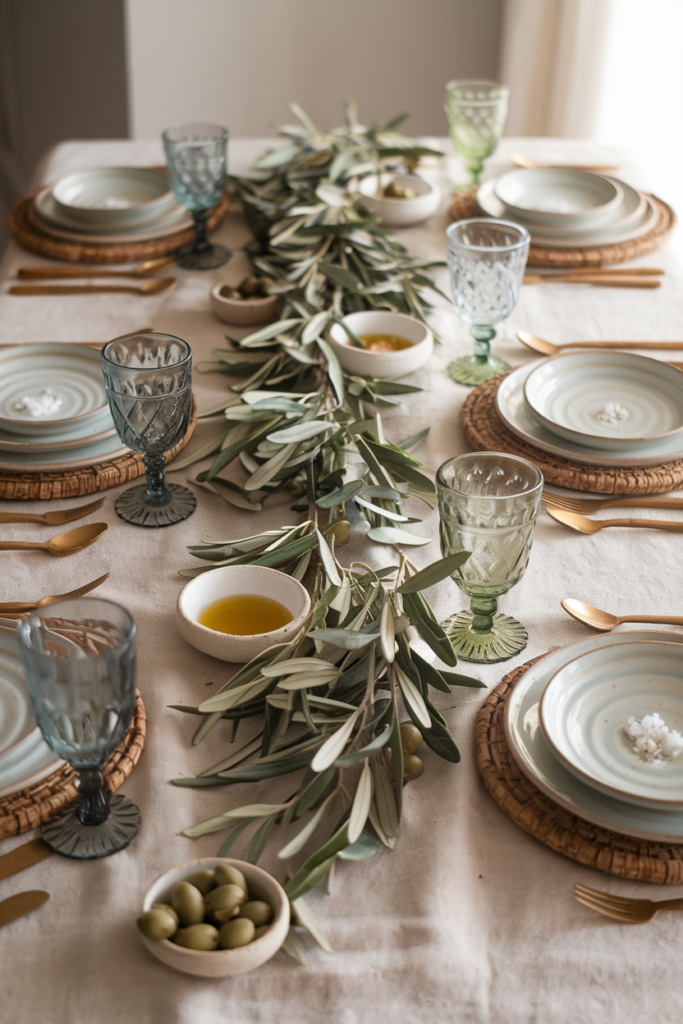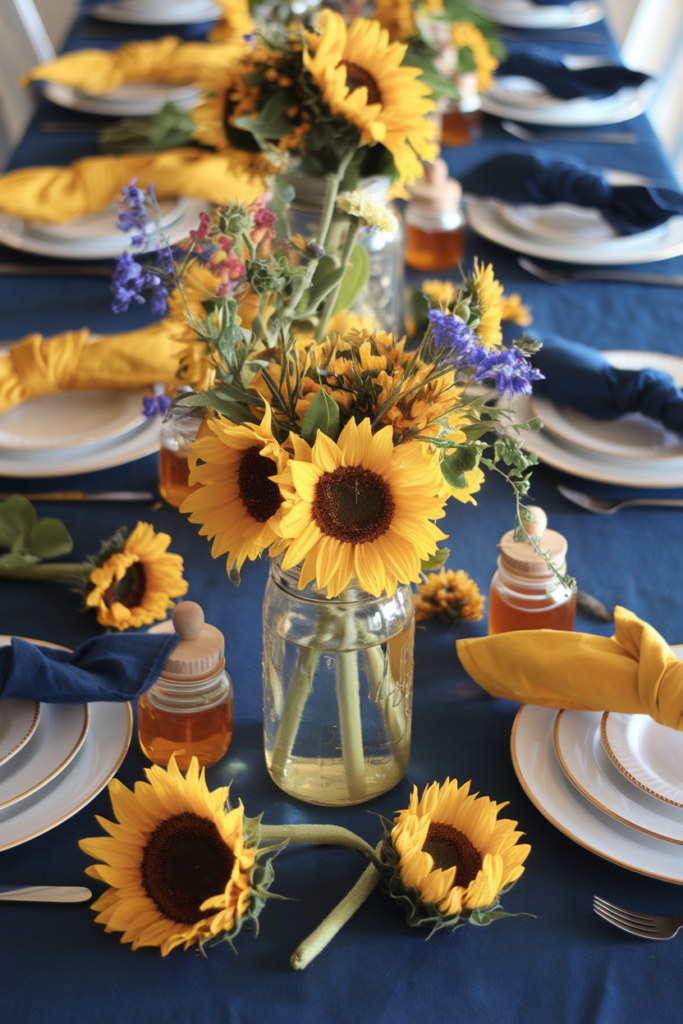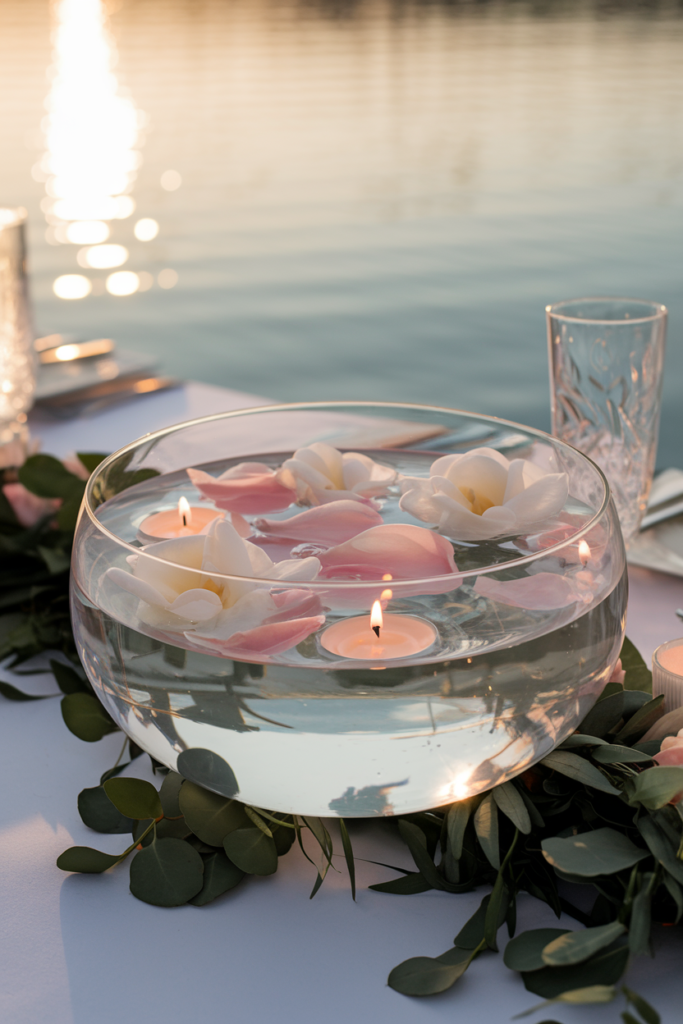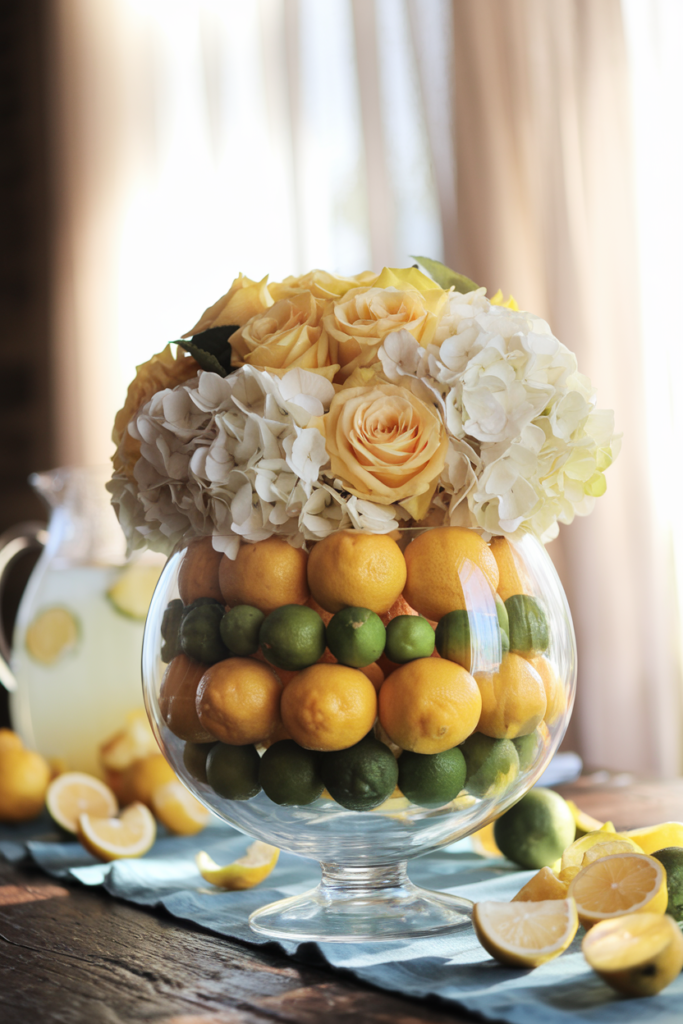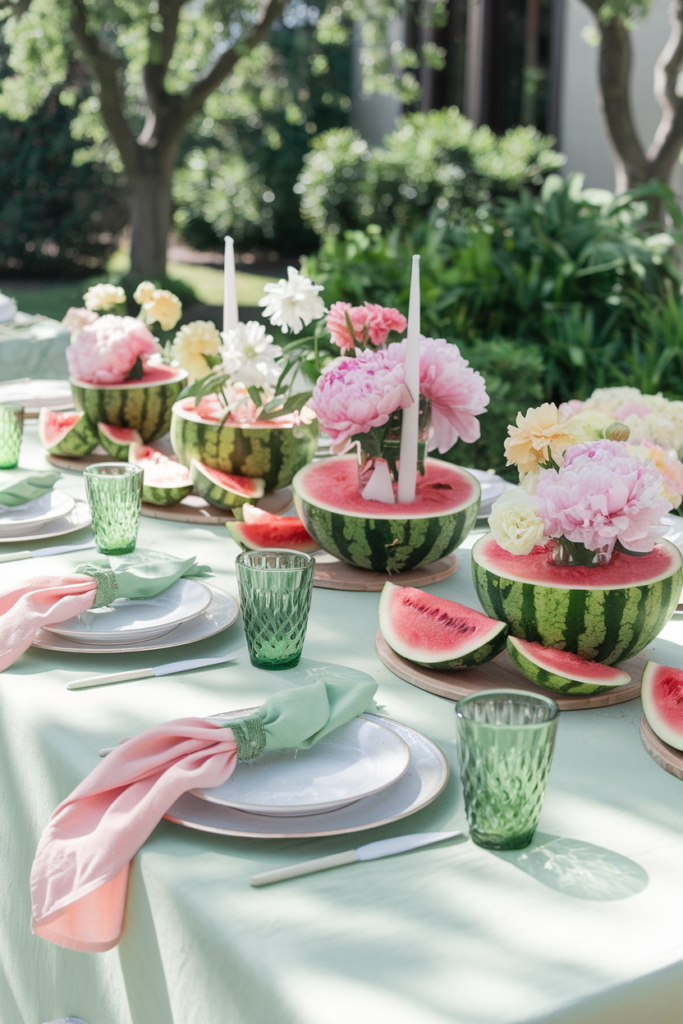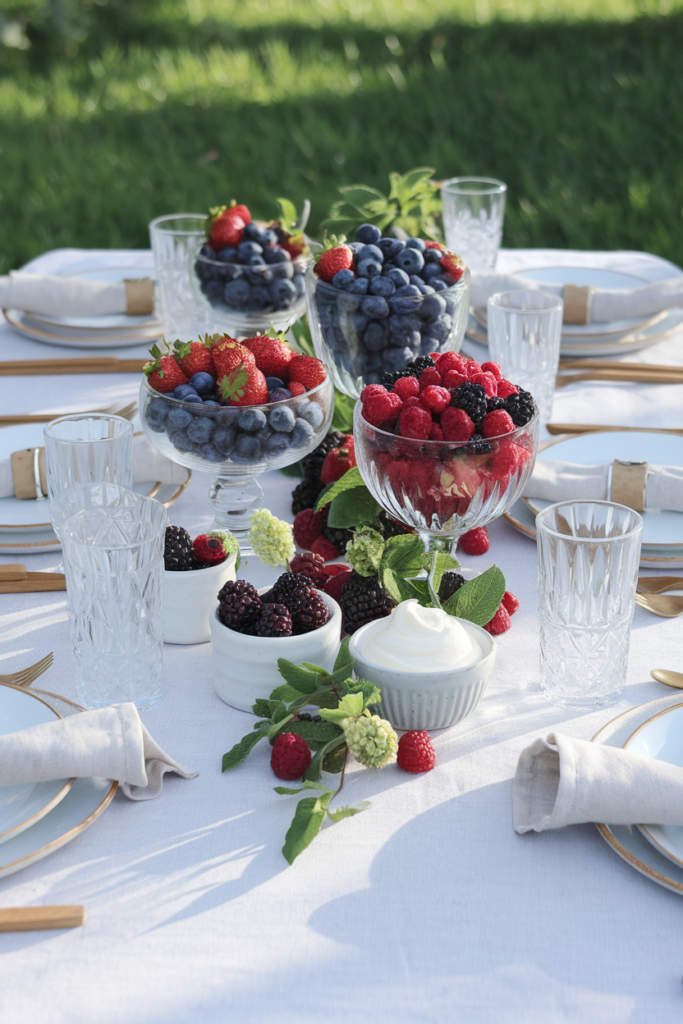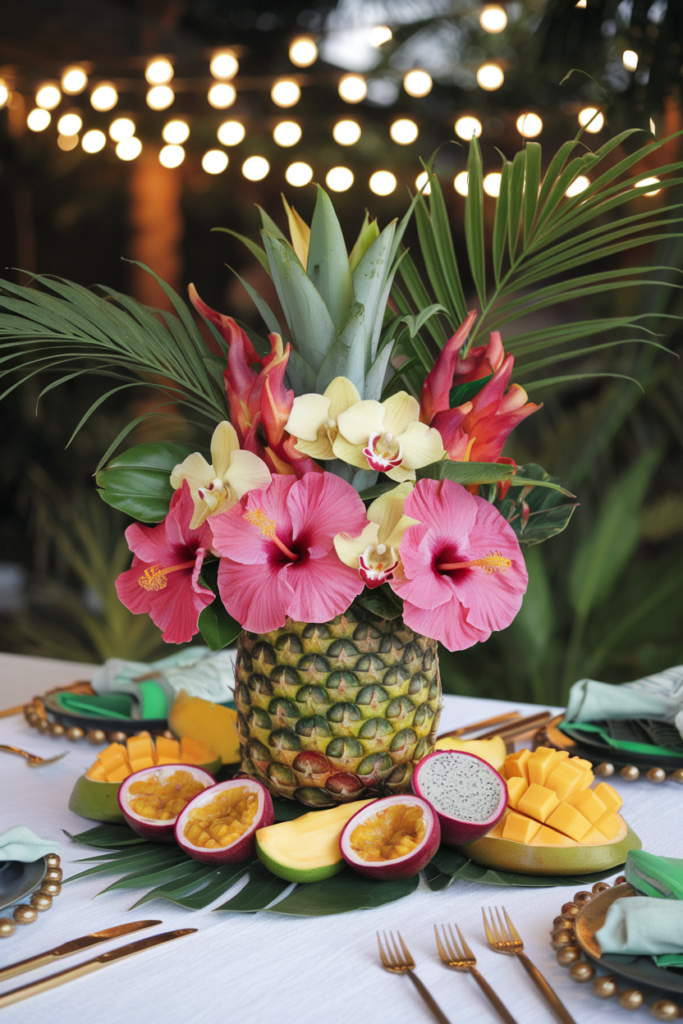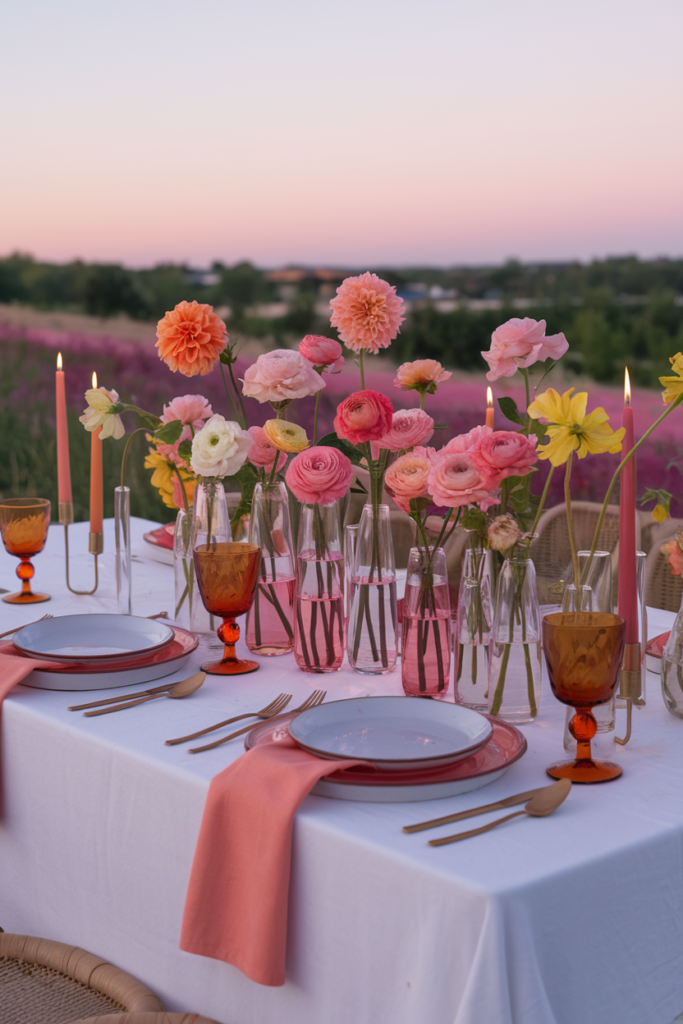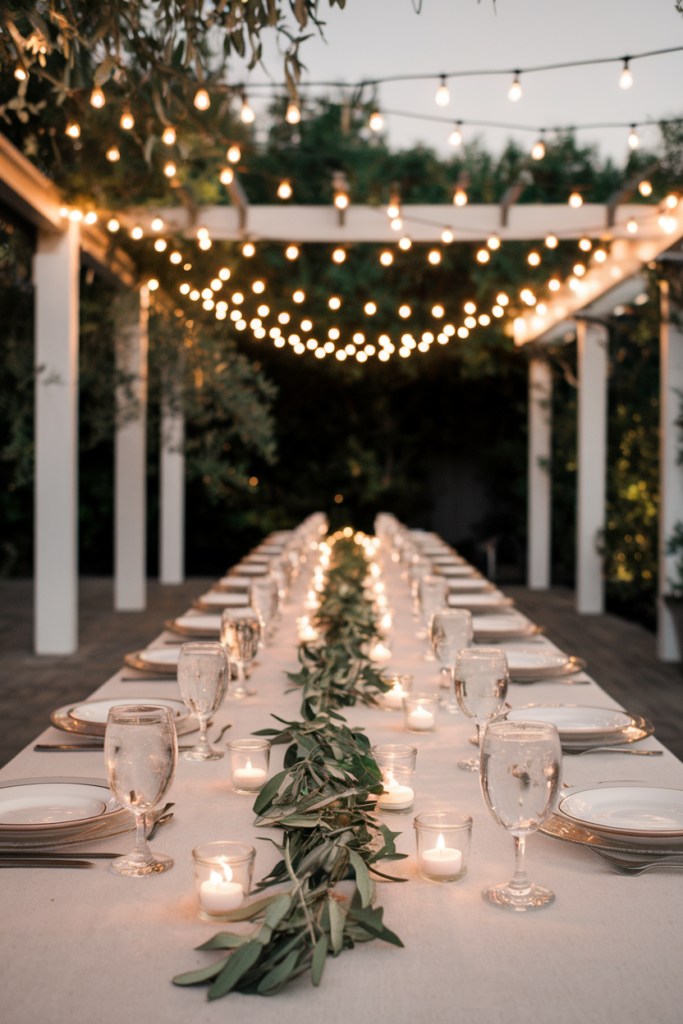There are affiliate links on this website. At no additional expense to you, I might receive a tiny commission.
This article shows How to Set a Beautiful Outdoor Dining Table for the Summer.
I used to think outdoor dining was just plastic plates and paper napkins. Maybe a citronella candle if you were feeling fancy. And table styling? That was for interior design magazines and people with too much time on their hands. But then somewhere along the line — maybe after my fifth disappointing patio dinner or maybe after spending too many midnight hours on Pinterest — I realized there’s a sweet spot between practical and magical.
A kind of barefoot elegance. Summer tablescaping. It’s this mix of weather-resistant practicality and ephemeral beauty that makes a meal feel like an occasion, not just refueling. Durable pieces that can handle a breeze, sure — but warmed up with linen napkins, flickering candles, something fresh-cut from the garden that morning. Outdoor-friendly plates interrupted by a single vintage water pitcher you refuse to leave inside just because it might rain later.
What I love most is the contrast. The rules of outdoor entertaining — everything needs to be unbreakable, wind-proof, kid-friendly — meet the gentle rebellion of making it beautiful anyway. Nothing matches perfectly. And that’s the point. Honestly, I think we all crave that balance. Practical, with poetry. Casual, but considered. Summer tablescaping isn’t just styling to me anymore. It’s a permission slip — to slow down, to celebrate Tuesday dinner, to let your outdoor space tell the story of the season instead of just being somewhere to eat standing up.
How to Set a Beautiful Outdoor Dining Table: A Summer Guide
Creating an inviting outdoor dining space is about embracing what makes outside eating special while solving for the challenges. Here’s my approach after years of both triumph and disaster:
Step 1 : Choose Your Location and Table
I’ve hosted dinners where the evening sun blinded half my guests and the table wobbled every time someone reached for their water glass. Location and stability matter more than any decorative element.
Find a spot that offers shade during your typical dining hours, or plan for umbrellas. Nothing kills conversation faster than everyone squinting and sweating through the salad course. I learned to pay attention to the sun’s path after an epic outdoor birthday dinner where everyone at the west end of the table abandoned their seats halfway through.
Size-wise, give everyone breathing room — that cramped-elbow feeling from indoor dining feels even worse outside where we expect spaciousness. My rule is 24 inches of table edge per person minimum. Sounds specific, but trust me on this one.
The table material sets the foundation for everything else. I started with a glass-top metal monstrosity that scorched fingerprints in summer and froze palms in spring. Now I know better. Wood, concrete, quality metal with a powder coating — something with character that can handle the elements. A table that doesn’t need babysitting lets you focus on the parts that make dining special.
Step 2 : Lay the Foundation: Table Linens
I resisted tablecloths outside for years. Seemed too fussy, too likely to end up in the neighbor’s yard after a gust of wind. But there’s something about fabric on a table that instantly transforms a space from “place to put plates” to “place to linger over another glass of wine.”
For summer, I lean toward natural fabrics that look better slightly rumpled. Linen that doesn’t need perfect ironing. Cotton that can be tossed in the wash when someone inevitably spills sangria. I have a blue striped runner that’s seen five summers of dinners and looks better now than when I bought it — that slightly worn quality tells the story of good meals past.
Don’t overlook placemats as an alternative. They won’t blow away as easily as tablecloths and create built-in spacing for place settings. Rattan, water hyacinth, even outdoor-friendly fabric placemats add texture without requiring a perfectly sized tablecloth for your particular table.
Step 3 : Set the Stage: Dinnerware and Flatware
After breaking three ceramic plates in one summer (and picking shards out of grass for weeks), I finally accepted that outdoor dining demands different dinnerware than indoor meals. But different doesn’t mean ugly.
The new melamine options are impressive — substantial weight, matte finishes that don’t scream “plastic,” designs that look handmade rather than mass-produced. I mix solid dinner plates with patterned salad plates that can handle a breeze. Stoneware works too if you’re dining on a stable surface and don’t mind the occasional chip adding character.
For flatware, weight matters even more outside than in. Flimsy plastic forks that snap mid-bite are the fastest way to ruin the vibe. Good stainless steel develops a beautiful patina over time outdoors, and the substantial feel makes even simple food seem more special. I keep outdoor-specific flatware in a caddy that can travel from kitchen to table easily.
Step 4 : Add Sparkle: Glassware
Nothing elevates an outdoor table like the right glassware catching late afternoon light. After one spectacular disaster involving bare feet, shattered wine glasses, and a trip to urgent care, I’ve mostly switched to quality acrylic for everyday outdoor dining.
The new acrylic options are almost indistinguishable from glass until you pick them up — they have the clarity without the risk. For special occasions though, I still risk real glassware because nothing beats that delicate clink during toasts.
I’ve found that slightly mismatched glasses actually work better outside than perfectly matching sets. The casual, collected-over-time feel suits the setting. I have blue-tinted water glasses, stemless wine glasses that won’t tip in the breeze, and some copper cups that develop a beautiful patina with age — they add dimension to the table without trying too hard.
Step 5 : The Heart of the Table: Centerpieces
This is where your tablescape becomes yours. I used to overthink centerpieces until I realized the best ones often come from what’s already around me. Garden clippings in various small vases. Herbs planted in terracotta pots down the center of the table. River stones collected on vacation scattered between candles.
For summer tables, I follow three centerpiece rules:
- Low enough that people can see each other across the table
- Stable enough that it won’t blow away with the first breeze
- Incorporates something fresh or natural that connects to the surroundings
The most successful centerpiece I ever created was the simplest — lemons and limes piled casually in a wooden bowl, surrounded by tea lights in glass holders. It took five minutes, cost almost nothing, and my friends still mention it years later.
Step 6 : Finishing Touches: Accents and Ambiance
These are the details that transform a table setting into an experience. Cloth napkins — not perfectly pressed, just clean and thoughtfully placed — add color and texture. I fold them simply or sometimes just tie a loose knot. Too-perfect napkin origami feels wrong outside.
Lighting changes everything, especially as daylight fades. I’ve collected solar lanterns that charge all day and automatically create magic as evening arrives. String lights overhead make even the simplest settings feel intentional. And there’s nothing like candlelight, though I’ve learned to protect flames with hurricane lanterns or glass cups that won’t tip over.
Some of my favorite outdoor dinners involved unexpected accents — tiny potted succulents that doubled as place cards and parting gifts. Fresh herbs in small jars that guests could tear and add to their plates. A polaroid camera passed around to capture moments that were later clipped to a string with tiny wooden clothespins, becoming part of the decor as the evening progressed.
Coastal & Nautical: Bringing the Beach to Your Backyard
I live three hours from the nearest coast, but something about blue and white in summer just feels right. There’s a reason coastal never goes out of style — it captures the relaxed yet refined feeling we all want in summer.
Seaside Serenity
The first coastal tablescape I attempted looked like a souvenir shop had exploded — too many shells, too much rope, nautical everything. Now I know restraint is the difference between themed and transported.
A simple white tablecloth creates the perfect blank canvas. I scatter just a few meaningful shells or sea glass down the center — the ones with stories, not the bags from craft stores. Small arrangements of white flowers (garden roses, hydrangeas, orchids ) in clear glass containers add height without blocking conversation.
What makes this work is the limited palette — whites, blues, natural wood tones — and the mix of textures. White ceramic plates on rattan chargers. Navy blue linen napkins with white edges. Clear glassware that catches light like water. Wood serving pieces that feel worn by salt air, even if they never left my landlocked state.
I hosted a birthday dinner with this theme last July, and the subtle maritime touches made an 85-degree evening feel cooler somehow. One friend asked if I’d changed the playlist to include waves, which I hadn’t — the power of visual suggestion is real.
Nautical Knot
For a slightly more structured take on coastal style, I lean into classic nautical elements without going overboard. A navy and white striped runner immediately sets the maritime mood without overwhelming the space. Solid white plates and natural linen napkins keep things grounded.
Instead of predictable sailor motifs, I focus on authentic materials that would actually be found on a boat — rope twisted into napkin rings, brass accents that develop a patina, canvas placemats with reinforced edges. The centerpiece might be vintage blue glass bottles holding single stems of white flowers, or brass candlesticks that look like they’ve weathered sea spray.
The secret is incorporating just enough nautical to suggest the theme without hitting people over the head with it. Skip the plastic anchors and captain’s wheels. A weathered wooden serving board that mimics a ship’s planks tells the story more subtly than obvious nautical kitsch.
Coastal Stripes
When full nautical feels too themed for everyday, coastal stripes offer the perfect compromise. A simple white tablecloth with a blue striped runner immediately evokes cabanas and beach umbrellas without trying too hard.
White plates let the textiles be the star. I sometimes add natural fiber placemats in a contrasting weave for more texture. Napkins might be solid blue or white, casually knotted rather than precisely folded. For glassware, anything with a subtle blue tint continues the coastal feel without being obvious.
The magic happens when you add natural elements that complement the striped foundation. Small arrangements of white garden roses and dusty miller mimic sea foam. Air plants require no water and add unexpected organic shapes. One summer I added tiny potted succulents in simple white pots along the runner, and guests took them home as mementos.
My neighbor tried this theme for a casual lunch and added her own genius touch — place cards made from smooth river stones, with guests’ names written in white ink. They doubled as perfect paperweights for napkins on breeze-prone days.
Garden & Nature Inspired: Bringing the Landscape to Your Table
I kill houseplants with remarkable consistency, but garden-inspired tablescapes forgive my black thumb. Nature isn’t perfect; your table doesn’t need to be either.
Wildflower Meadow
There was a summer I tried to grow wildflowers from seed. The garden was a spectacular failure, but it inspired my favorite tablescape — a meadow-like arrangement that feels intentionally untamed.
The foundation is simple: natural linen in oatmeal or soft green. Instead of one perfect centerpiece, I scatter several small vessels down the table — mason jars, bud vases, even drinking glasses — filled with whatever is growing nearby. Grocery store flowers work too, chosen for variety rather than perfection. The key is mixing heights, colors, and textures to create that meadow-like feeling.
This approach works best with simple dinnerware that doesn’t compete with the flowers. White plates or natural stoneware provide a neutral canvas. Napkins in soft lavender or butter yellow pick up colors from the flowers without matching too exactly.
The beauty of this tablescape is how it changes with the seasons. Early summer brings delicate blooms in softer hues; late summer delivers more dramatic colors and sturdier stems. You work with what’s available, which keeps things fresh and truly seasonal.
Herb Garden Delight
The most practical tablescape I’ve discovered is also one of the most beautiful. Small potted herbs arranged down the center of the table look lush and inviting while serving an actual purpose — guests can pluck fresh basil for their pasta or mint for their mojitos.
I keep the foundation neutral — a natural linen runner on a wooden table lets the greens be the star. Terracotta pots feel appropriately earthy, though sometimes I’ll transfer herbs to simple white ceramic vessels for a more modern look. Small wooden plant markers identify each herb for guests who might not recognize them all by sight.
This arrangement appeals to multiple senses. Beyond the visual green tapestry, there’s the fragrance released when someone brushes against rosemary or thyme. There’s the tactile experience of tearing herbs to add to food. And of course, the flavor they add to the meal itself.
After dinner, I’ve been known to send guests home with cuttings to root — the tablescape that keeps on giving long after the plates are cleared.
Olive Grove Escape
I’ve never been to Tuscany (despite watching “Under the Tuscan Sun” approximately 37 times), but my olive branch tablescape transports dinner guests there anyway. It’s Mediterranean simplicity at its best.
The foundation is rustic linen in natural oatmeal or soft green. Down the center, I arrange olive branches (from my local florist, though sometimes I substitute eucalyptus which lasts forever and smells amazing). Small white ceramic bowls of olives, sea salt, and good olive oil become both décor and appetizer.
Earthy stoneware in whites and soft blues continues the Mediterranean feel. Wooden serving boards and simple metal serving pieces add utilitarian beauty. The glassware is deliberately mismatched — some clear, some with a subtle blue or green tint — like pieces collected over time from village markets.
This tablescape feels sophisticated without trying too hard. The olive branches last for weeks, making it practical for everyday dining as well as special occasions. When a friend got engaged at a dinner with this theme, she said the setting made it feel like they were somewhere far more exotic than my backyard. I didn’t correct her.
Rustic Sunflower
Some flowers are too bossy for subtle arrangements. Sunflowers are like that friend who walks into a room and immediately becomes the life of the party. My sunflower tablescape embraces their exuberant energy.
I start with a deep blue tablecloth for dramatic contrast. Mason jars of varying heights hold sunflowers mixed with simple greenery and maybe some smaller yellow blooms for cohesion. A scattering of smaller sunflower heads directly on the table adds whimsy.
This bold centerpiece needs balanced dinnerware — white plates let the flowers be the focus. Napkins in yellow or blue continue the color story. Honey pots with wooden dippers make perfect functional accents, nodding to the relationship between sunflowers and bees.
This arrangement has a distinctly American farmhouse feel that works perfectly for Fourth of July gatherings or late summer harvests. It’s impossible to feel formal or stuffy around sunflowers — they practically demand that people relax and enjoy themselves.
Floating Floral Serenity
I used to think floating flowers were just for spa waiting rooms or fancy hotel lobbies. Too precious, too likely to spill all over your grandmother’s tablecloth. But after one particularly hectic summer, I craved something that felt like a deep breath on my outdoor table—something that moved gently and reflected light.
The setup is deceptively simple—a wide, shallow glass bowl (actually a thrift store trifle dish) filled with water so clear you’d swear it wasn’t there. Inside float gardenia blossoms I carefully cut from the neighbor’s bush (with permission, mostly) and soft pink rose petals that break free from my sad attempt at gardening. Between them, tea lights in tiny glass holders create pools of golden light that dance across the water’s surface with every breeze.
I circle the bowl with sprigs of eucalyptus, their silvery-green leaves adding structure to all that softness. What makes this arrangement work is the interplay between stillness and movement—structured glass container, fluid water, flowers that drift and reposition themselves throughout the evening. When the sunset hits just right, everything takes on this amber glow that makes even store-bought hummus look sophisticated. My analytical engineer friend called it “unnecessarily beautiful” at our last dinner—which might be the best compliment a tablescape could receive.
Vibrant & Fruity: Edible Centerpieces That Double as Dessert
The most practical tablescapes incorporate elements you’ll actually use. Fruit centerpieces aren’t just beautiful — they’re a zero-waste way to decorate that transforms into dessert or next morning’s breakfast.
Citrus Burst
The simplest tablescape I’ve ever created might also be my favorite — a collection of citrus fruits arranged casually down the center of the table. The beauty is in the abundance and natural color variation.
I start with a white tablecloth or wood table for contrast. Lemons, limes, oranges, even pink grapefruit create an ombré effect when arranged together. Sometimes I’ll slice a few to reveal the intricate internal patterns, but mostly I let their natural forms speak for themselves.
White plates and clear glassware keep the focus on the fruit. Napkins might pick up one shade from the citrus spectrum — soft yellows or corals. The overall effect feels fresh, clean, and infinitely summer.
This centerpiece works especially well for brunch or lunch when the bright colors match daylight’s energy. As a bonus, the subtle citrus fragrance acts as natural air freshener. After the meal, leftover fruit becomes tomorrow’s lemonade or gets sliced into water pitchers.
Watermelon Wonder
There’s something unapologetically summer about watermelon — it’s not trying to be sophisticated or subtle, just gloriously juicy and joyful. A watermelon-themed tablescape embraces that same energy.
I start with a light green tablecloth or runner that echoes the melon’s rind. Small watermelons cut in half become natural containers for flowers or candles. Slices arranged on platters add color. For longer tables, I alternate these elements to create rhythm.
The dinnerware should be simple — white plates let the watermelon be the star. Napkins in pink or green continue the theme without being matchy-matchy. Green glass tumblers add dimension without competing.
This arrangement is particularly perfect for casual gatherings where you want people to linger. There’s something about watermelon that encourages conversation and triggers childhood memories. One friend told me a dinner with this theme was the first time she’d seen her husband eat watermelon since he was ten years old — it broke through his adult food pretensions in the best possible way.
Berry Bliss
Berries might be small, but arranged en masse, they create a tablescape that’s both elegant and approachable. Their jewel tones add rich color without the formality of traditional floral arrangements.
I start with a neutral foundation — natural linen or a simple white tablecloth. Small white bowls or clear glass vessels filled with single-variety berries create a modern, almost color-blocked effect down the table’s center. Strawberries, blueberries, blackberries, raspberries — each in their own container but arranged in a collective display.
Green leaves tucked between the vessels (mint, lemon verbena, small berry branches with leaves attached) add natural contrast. The overall effect feels abundant without being overcomplicated.
This arrangement works beautifully with white plates and simple glassware. Napkins can pick up one berry tone or stick to classic white or natural linen. The beauty of this centerpiece is that after dinner, the berries can be combined with a little whipped cream for an instant dessert.
Festive & Whimsical: When You Want Dining to Feel Like a Celebration
Some occasions call for tablescapes that feel like a party before the first guest arrives. These arrangements prioritize mood and memory-making over tradition.
Tropical Paradise
I’ve never lived anywhere with palm trees, which might explain my obsession with creating island-inspired tablescapes that transport dinner guests to shores I’ve only visited in daydreams. This arrangement whispers “vacation” even when you’re just having Tuesday leftovers on your back patio.
The foundation is bold — a tablecloth in crisp white that makes every color pop like fireworks against a night sky. The star of the show? A hollowed-out pineapple I transformed into a vase after watching one too many tropical resort videos on my lunch break. It sits center stage, overflowing with pink hibiscus flowers and bright yellow orchids I splurged on at the farmer’s market, with palm leaves fanning out like nature’s exclamation points.
What makes this work is the controlled chaos. The formality of white linen playing against the wild organic shapes. Golden cutlery catches light in unexpected ways — a yard sale find that suddenly looks expensive against all that white. I scattered sliced tropical fruits around the pineapple centerpiece — the halved mangoes with their sunset gradient, passionfruit with their alien-like interiors, dragon fruit that looks like it’s wearing polka dots. They’re not just decorative — they’re dessert waiting to happen.
I hung string lights overhead just low enough to create pools of warm light without blinding anyone. They’re the finishing touch that transforms a simple dinner into something worth remembering. Last summer, I hosted my sister’s birthday with this setup, and she swore she could hear ocean waves. It was just the neighbor’s sprinkler system, but I didn’t correct her. Sometimes the suggestion of escape is powerful enough to create the feeling, if only for one meal. The tiki-inspired cocktail stirrers I found online completed the illusion — little details that say “this isn’t just dinner, it’s a destination.
Sunset Hues
Some of my favorite outdoor dinners have happened during that magical hour when the sky turns pink and gold. This tablescape attempts to capture that fleeting moment and extend it throughout the meal.
I start with a white tablecloth to mimic canvas for the “painted” sunset. The centerpiece consists of bud vases with flowers arranged in ombré fashion — moving from deep oranges through corals and pinks to pale yellows, mimicking the colors of sunset. Candles in similar hues add dimension and will continue the color story after the sun goes down.
White plates keep the focus on the sunset gradient. Napkins might pick up one tone from the spectrum — perhaps coral or gold. Glassware with a subtle amber tint catches the evening light beautifully.
This arrangement creates a natural conversation starter as the actual sunset happens, with guests often comparing nature’s version to your tablescape interpretation. It’s particularly perfect for those dinner parties that you hope will linger late into the evening.
String Light Magic
Sometimes the most impactful tablescape isn’t about what’s on the table at all, but what’s above it. My string light arrangement focuses on creating an atmosphere of enchantment that transforms any meal into an occasion.
The table itself can be relatively simple — perhaps a neutral tablecloth or runner, simple white plates, and clear glassware. The magic happens overhead with layers of string lights creating a canopy of stars. Some strands hung higher, some lower, some draped along nearby structures — the layered effect creates depth.
On the table itself, small vessels with tea lights reflect and multiply the overhead glow. The centerpiece remains intentionally minimal — perhaps just some greenery or very simple flowers that won’t compete with the light display above.
This arrangement comes into its full glory at dusk, when the lights begin to twinkle against the deepening blue sky. It creates a distinct transition from day to evening, signaling to guests that there’s no rush to end the gathering. Some of my longest, most memorable dinner parties have happened under these lights, with conversations stretching hours past the meal itself.
Tips from an Expert
- Always have a plan for wind — secure lightweight items with discreet weights or choose heavier alternatives.
- Consider the entire sensory experience — the sound of ice in glasses, the scent of herbs or flowers, the feel of napkins against skin.
- Keep a “summer emergency kit” nearby with bug spray, sunscreen, and extra candles or light sources.
- Remember that outdoor dining should feel more relaxed than indoor meals — perfection isn’t the goal, connection is.
- Always have a “plan B” location in case of sudden weather changes.
Final Thoughts
Creating beautiful summer tablescapes isn’t about following rigid rules or buying expensive decorations. It’s about noticing what makes you feel good outdoors — the quality of light, the textures of natural materials, the colors that remind you of childhood summers — and bringing those elements to your table.
My favorite outdoor gatherings aren’t the ones where everything matched perfectly. They’re the ones where the setting felt special enough that people lingered, where the tablescape sparked conversation, where no one wanted to be the first to leave even as stars appeared overhead.
Your summer table doesn’t need to look like anyone else’s Pinterest board. It just needs to feel like a place where time slows down, where food tastes better, where memories get made. A place that feels like summer, and like you.
What summer tablescape are you inspired to create? Save this post for later and tell me in the comments which style speaks to your summer entertaining plans!
